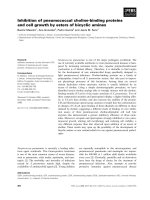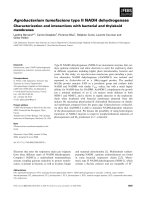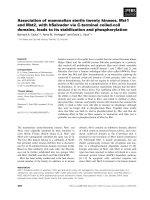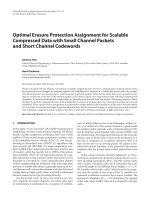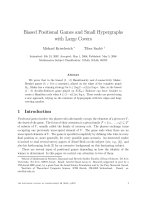SMALL ESTERS, KETONES, AND AMINES WITH LARGE AMPLITUDE MOTIONS - Full 10 điểm
Bạn đang xem bản rút gọn của tài liệu. Xem và tải ngay bản đầy đủ của tài liệu tại đây (12.43 MB, 236 trang )
Small Esters, Ketones, and Amines with
Large Amplitude Motions
Von der Fakultät für Mathematik, Informatik und Naturwissenschaften der
RWTH Aachen University zur Erlangung des akademischen Grades einer
Doktorin der Naturwissenschaften genehmigte Dissertation
vorgelegt von
Dipl.-Chem.
Ha Vinh Lam Nguyen
aus Hanoi
(Vietnam)
Berichter: Universitätsprofessor Dr. rer. nat. W. Stahl
Universitätsprofessor Dr. rer. nat. A. Lüchow
Tag der mündlichen Prüfung: 08.03.2012
Diese Dissertation ist auf den Internetseiten der Hochschulbibliothek online verfügbar.
For the thorn birds.
Yesterday is history. Tomorrow is mystery. But today is the gift. That’s why it’s called
PRESENT.
Grand Master Oogway (Kung Fu Panda)
Acknowledgement
I owe my deepest gratitude to Prof. Dr. rer. nat. W. Stahl who has always leaded and helped
me since many years not only in my study but also in my life. From the small research
projects to my diploma thesis, from my first paper to this dissertation would not have been
successful without his help. I would like to thank for his advice on life and for every story he
told me. There were some long ones, sometimes only one or two sentences, but every time I
received meaningful lessons.
I would like to thank Prof. Dr. rer. nat. A. Lüchow for the advise in quantum chemical
questions. It is a pleasure to thank Dr. I. Kleiner for the excellent cooperation, for her support
and the nice discussions for many papers, meetings, and proposes.
My dear colleagues - my lovely girlfriends, D. Lucht, H. Mouhib, L. Sutikdja, Y. Zhao, L.
Tulimat, have always supported me during my work and shared weal and woe like a real
family. I would like to thank them for their helpful hints and support.
I am indebted to my parents who brought me up, give me a sufficient and happy life, and
guided me to study in the wonderful country, Germany. This thesis would not have been
possible without their support. I would like to show my gratitude to Minh, my sister, for her
love and amusement which brought me many experience of life.
I thank my small family for the smile, the care, and the endless love which gave me energy
and belief in my work and my life.
I am deeply grateful to all of my friends in the beautiful city Aachen who made the habitation
here one of the most beautiful time in my life.
At last, I would like to thank the past days. Not only the happy days but also the blue days
have brought me more and more love for today.
Cảm ơn thầy, GSTSKH W. Stahl, người trong bao nhiêu năm qua đã ln dìu dắt, giúp đỡ em
khơng chỉ trong học tập. Từ những nghiên cứu nhỏ ñến luận văn tốt nghiệp thạc sĩ, từ những
bài báo ñầu tiên ñến ñến luận văn tiến sĩ này, tất cả sẽ khơng thể thành cơng như thế nếu
khơng có sự chỉ dẫn tận tình của thầy. Cảm ơn thầy về những lời khuyên trong cuộc sống,
cảm ơn thầy về những câu chuyện thầy kể, lúc dài, khi chỉ một hai câu, nhưng ln cho em
những bài học đầy ý nghĩa.
Cảm ơn GSTSKH A. Lüchow về những chỉ bảo tận tình của thầy mỗi khi em gặp khó khăn.
Cảm ơn TS I. Kleiner về những dự án chung và những bài báo tuyệt vời.
Cảm ơn Daniela, Halima, Lilian, Yueyue, Layla, những cô bạn đồng nghiệp, những cơ bạn
gái đáng u đã ln giúp tớ trong công việc cũng như luôn sẻ chia về tinh thần như một gia
đình thật sự.
Cảm ơn bố mẹ đã ni dạy con lớn khơn, cho con một cuộc sống ñủ ñầy và hạnh phúc, cho
con học ở ñất nước Đức xinh ñẹp ñể con có ñược thành cơng, để hơm nay có luận văn tốt
nghiệp này. Cảm ơn bố mẹ đã ln ở bên con những khi vui cũng như những lúc khó khăn,
động viên và hỗ trợ con cả về tinh thần và vật chất ñể con có thể tập trung hồn thành tốt cơng
việc của mình.
Cảm ơn dì Minh đã chăm sóc cho bố mẹ trong suốt thời gian chị đi học. Khơng có em, chắc
chắn chị không thể yên tâm làm việc và cũng khơng thể viết được một luận văn tiến sĩ mà chị
rất hài lịng. Cảm ơn em về tình u và những chia sẻ ñã cho chị nhiều trải nghiệm về cuộc
sống và bản thân mình.
Cảm ơn gia đình nhỏ của tơi vì những nụ cười, sự quan tâm và tình u vơ bờ bến đã đem lại
cho tơi niềm tin và nghị lực trong công việc.
Cảm ơn thành phố Aachen xinh ñẹp với những người bạn ñã làm cho quãng thời gian ở ñây
trở thành một trong những khoảng thời gian đẹp nhất của cuộc đời tơi.
Và cuối cùng, xin cảm ơn những ngày ñã qua! Những ngày hạnh phúc cũng như khổ đau đều
cho tơi thêm u cuộc sống và thêm yêu ngày hôm nay.
Contents
Introduction 1
Experimental setup 2
A. Internal rotation
Introduction 4
Chapter 1
Ethyl acetate
One rotor and CS frame symmetry
1. Introduction 11
2. Quantum chemistry 11
3. Microwave spectrum
3.1. Spectral assignment 14
3.2. The XIAM and the BELGI-CS codes 17
4. Results and discussion 20
5. Conclusion 24
References
Chapter 2
Allyl acetate
One rotor and C1 frame symmetry
1. Introduction 26
2. Microwave spectrum 27
3. Quantum chemistry 31
4. Results and discussion 34
5. Conclusion 38
References
ICNOTNETRENNATLSROTATION
Chapter 3
Vinyl acetate
Quantum chemical calculations and improvement of the fit
1. Introduction 40
2. Quantum chemistry 40
3. Microwave spectrum 43
4. Results and discussion 43
5. Conclusion 45
References
Chapter 4
Isopropenyl acetate
Two rotors and C1 frame symmetry
1. Introduction 47
2. Quantum chemistry 48
3. Microwave spectrum
3.1. Symmetry labels 50
3.2. Spectral assignment 50
4. Results and discussion 52
5. Conclusion 55
References
Chapter 5
Methyl propionate
Two rotors and CS frame symmetry
1. Introduction 57
2. Quantum chemistry 58
3. Microwave spectrum
3.1. Spectral assignment 61
3.2. The XIAM and the BELGI-CS-2tops codes 64
4. Results and discussion 65
5. Conclusion 68
References
CONTENTS
Chapter 6
Diethyl ketone
Two equivalent rotors and C2v frame symmetry
1. Introduction 70
2. Quantum chemistry 71
3. Microwave spectrum
3.1. Symmetry labels 75
3.2. Spectral assignment 75
4. Results and discussion 77
5. Conclusion 80
References 80
Chapter 7
Acetone
New aspects of the internal rotation in acetone
1. Introduction 82
2. Quantum chemistry 82
3. Microwave spectroscopy 86
4. Conclusion 88
References 89
Discussion 90
B. Nitrogen inversion tunneling
Introduction 94
Chapter 8
Diethyl amine
The effects of nitrogen inversion tunneling, methyl internal rotation, and 14N
quadrupole coupling
1. Introduction 99
2. Quantum chemistry 100
ICNOTNETRENNATLSROTATION
3. Microwave spectrum 100
3.1. Overall rotation and nitrogen inversion tunneling 101
3.2. 14N nuclear quadrupole coupling 107
3.3. Methyl internal rotation 107
4. Analysis and discussion 107
5. Conclusion 115
6. Appendix I: Proton tunneling 117
References 118
Chapter 9
Methyl tert-butyl amine
Nitrogen inversion tunneling, 14N quadrupole coupling, and internal rotation in an
almost prolate symmetric top (κ = −0.994)
1. Introduction 120
2. Quantum chemistry 121
3. Microwave spectrum 123
4. Results and discussion 124
5. Conclusion 129
References 129
Chapter 10
Triethyl amine
Conformational landscape – the wind mill structure found in an oblate symmetric top
1. Introduction 130
2. Quantum chemistry 131
3. Microwave spectrum
3.1. Main isotopologue 133
3.2. 13C isotopologue 133
4. Discussion 138
5. Conclusion 139
6. Appendix: Quantum chemical calculations on related molecules
6.1. Triethyl phosphane 139
6.2. Triisopropyl amine, tri-n-propyl amine, and tri-tert-butyl amine 140
References 141
Conclusion ethyl acetate CONTENTS
allyl acetate
Appendix vinyl acetate 144
isopropenyl acetate
A. Chapter 1 methyl propionate 147
B. Chapter 2 diethyl ketone 153
C. Chapter 3 acetone 160
D. Chapter 4 diethyl amine 164
E. Chapter 5 methyl tert-butyl amine 178
F. Chapter 6 triethyl amine 188
G. Chapter 7 199
H. Chapter 8 204
I. Chapter 9 213
J. Chapter 10 215
1
Introduction
The rotational energy levels of a rigid body are completely determined by its three principal
moments of inertia. However, for many molecules this simple rigid body approach is often
not sufficient, since there are effects like centrifugal distortion, small amplitude motions (e.g.
vibrations), and large amplitude motions which make it necessary to modify the simple rigid
rotor model. This thesis deals with investigations on small molecules which exhibits
important type of large amplitude motions, internal rotation and nitrogen inversion tunneling,
by a combination of molecular beam Fourier transform microwave (MB-FTMW)
spectroscopy and quantum chemical calculations.
MB-FTMW spectroscopy is an excellent tool to study molecular structure and dynamics. By
this way a large number of molecules were investigated. The classical method to determine
the molecular structure is isotopic substitution which was applied for the first assignment of
almost every small molecule like hydrogen cyanide HCN,1 cyanamid NH2−CN,2
diazomethane CH2=N=N,3 formaldehyde,4,5 to somewhat larger molecules like methanol,6
formamide,7,8 ethanol,9 glycol aldehyd,10,11 etc. Sursprisingly, only very few simple esters,
ketones, and amines were among them, though they are very important class in chemistry.
This might be due to the fact that even small esters, ketones, and amines contain quite a large
number of atoms which makes them too big for classical structure determination by isotopic
substitution. Moreover, even under molecular beam conditions usually several conformers
exist. For those molecules, conformers can be identified by comparing the experimental data
with quantum chemical calculations carried out using the program Gaussian03 12 and
Gaussian09 13 package. Different methods like Møller-Plesset perturbation theory of second
order (MP2) and B3LYP density function of theory and basis sets were chosen and compared.
Frequency calculations were carried out in addition to structure optimizations. In many
molecules energy potential curve and energy potential surface were calculated to study the
interaction in the molecules. Theory to quantum chemical calculations has been reported in
many books (e.g. Cramer 14) and papers (e.g. ref. 15,16) and therefore will not be repeated here.
The combination of microwave spectroscopy and quantum chemical calculations was a
successful method to assign the rotational spectrum with splittings due to internal rotation of
trans ethyl acetate (Chapter 1, published in J. Mol. Spectrosc. 257, 111 (2009)), allyl acetate
2 INTERRONDAULCTRIOOTNATION
(Chapter 2, published in Mol. Phys. 108, 763 (2010)), vinyl acetate (Chapter 3), isopropenyl
acetate (Chapter 4, published in J. Mol. Spectrosc. 264, 120 (2010)), and methyl propionate
(Chapter 5, submitted to Mol. Phys. 2012). In all cases structure optimization and energy
potential curve were carried out for identify the conformer. Two ketones, diethyl ketone
(Chapter 6, published in Chem. Phys. Chem. 12, 1900 (2011)) and acetone (Chapter 7), were
also investigated. Here, the energy potential surfaces were additionally calculated to study the
interaction between two equivalent internal methyl rotors.
For assignment of molecules with nitrogen inversion tunnelling like diethyl amine (Chapter 8,
published in J. Chem. Phys. 135, 024310 (2011), doi:10.1063/1.3607992) and methyl tert-
butyl amine (Chapter 9) only structure optimization and frequency calculations were
necessary. In the case of triethyl amine (Chapter 10, paper in progress) many geometries can
be generated by rotating the three ethyl groups. Quantum chemical calculations turned out to
be very helpful to determine the possible stable conformers and carried out an orientation for
the spectrum assignment.
Experimental setup
All spectra used throughout this thesis were recorded using two MB-FTMW spectrometers in
the frequency ranges 4 to 26.5 GHz and 26.5 to 40 GHz. They are modified versions of those
described in ref. 17,18 and ref. 19, respectively. All substances were obtained from Merck
Schuchardt OHG, Hohenbrunn, Germany, and used without further purification. A gas
mixture containing 1% substance in helium at a total pressure of 100 to 200 hPa was used
throughout. We have chosen helium as a carrier gas because the cooling is not as effective as
with argon or neon and therefore also higher J levels can still be observed.
The spectrometers can be operated in two different modes, the high resolution mode and the
scan mode. In the high resolution mode all lines are split into doublets due to the Doppler
effect. The molecular transition frequency is the center frequency. The splitting depends on
both, the center frequency and the velocity of the molecular beam. In the scan mode a series
of overlapping spectra taken in the high resolution mode are automatically recorded and only
the presence of lines is indicated in a broad band scan.
INTRODUCTION 3
References
1J. W. Simmons, W. E. Anderson, W. Gordy, Phys. Rev. 77, 77 (1950).
2J. K. Tyler and J. Sheridan, Proc. Chem. Soc. 155 (1959).
3A. P. Cox, L. F. Thomas, J. Sheridan, Nature 181, 1000 (1958).
4R. B. Lawrence and M. W. P. Strandberg, Phys. Rev. 83, 363 (1951).
5H. Hirakawa, T. Oko, K. Shimoda, J. Phys. Soc. Japan 11, 1207 (1956).
6R. H. Hughes, W. E. Good, D. K. Coles, Phys. Rev. 84, 418 (1951).
7R. J. Kurland, Bull. Am. Phys. Soc. 1, 12 (1956).
8C. C. Costain and J. M. Dowling, J. Chem. Phys. 32, 158 (1960).
9L. M. Imanov, Ch. O. Kadzhark, I. D. Isaev, Opt. Spectrosc. 18, 194 (1965).
10M. A. Simons and R. C. Woods, Symp. Mol. Struct. & Spectrosc. Ohio 47 (1969).
11K. M. Marstokk and H. Møllendal, J. Mol. Struct. 5, 205 (1970).
12Gaussian 03, Revision D.02, M. J. Frisch, G. W. Trucks, H. B. Schlegel, G. E. Scuseria, M. A. Robb, J. R.
Cheeseman, J. A. Montgomery, Jr., T. Vreven, K. N. Kudin, J. C. Burant, J. M. Millam, S. S. Iyengar, J. Tomasi,
V. Barone, B. Mennucci, M. Cossi, G. Scalmani, N. Rega, G. A. Petersson, H. Nakatsuji, M. Hada, M. Ehara, K.
Toyota, R. Fukuda, J. Hasegawa, M. Ishida, T. Nakajima, Y. Honda, O. Kitao, H. Nakai, M. Klene, X. Li, J. E.
Knox, H. P. Hratchian, J. B. Cross, V. Bakken, C. Adamo, J. Jaramillo, R. Gomperts, R. E. Stratmann, O.
Yazyev, A. J. Austin, R. Cammi, C. Pomelli, J. W. Ochterski, P. Y. Ayala, K. Morokuma, G. A. Voth, P.
Salvador, J. J. Dannenberg, V. G. Zakrzewski, S. Dapprich, A. D. Daniels, M. C. Strain, O. Farkas, D. K.
Malick, A. D. Rabuck, K. Raghavachari, J. B. Foresman, J. V. Ortiz, Q. Cui, A. G. Baboul, S. Clifford, J.
Cioslowski, B. B. Stefanov, G. Liu, A. Liashenko, P. Piskorz, I. Komaromi, R. L. Martin, D. J. Fox, T. Keith, M.
A. Al-Laham, C. Y. Peng, A. Nanayakkara, M. Challacombe, P. M. W. Gill, B. Johnson, W. Chen, M. W.
Wong, C. Gonzalez, J. A. Pople, Gaussian, Inc., Wallingford CT, 2004.
13Gaussian 09, Revision A.02, M. J. Frisch, G. W. Trucks, H. B. Schlegel, G. E. Scuseria, M. A. Robb, J. R.
Cheeseman, G. Scalmani, V. Barone, B. Mennucci, G. A. Petersson, H. Nakatsuji, M. Caricato, X. Li, H. P.
Hratchian, A. F. Izmaylov, J. Bloino, G. Zheng, J. L. Sonnenberg, M. Hada, M. Ehara, K. Toyota, R. Fukuda, J.
Hasegawa, M. Ishida, T. Nakajima, Y. Honda, O. Kitao, H. Nakai, T. Vreven, J. A. Montgomery, Jr., J. E.
Peralta, F. Ogliaro, M. Bearpark, J. J. Heyd, E. Brothers, K. N. Kudin, V. N. Staroverov, R. Kobayashi, J.
Normand, K. Raghavachari, A. Rendell, J. C. Burant, S. S. Iyengar, J. Tomasi, M. Cossi, N. Rega, J. M. Millam,
M. Klene, J. E. Knox, J. B. Cross, V. Bakken, C. Adamo, J. Jaramillo, R. Gomperts, R. E. Stratmann, O. Yazyev,
A. J. Austin, R. Cammi, C. Pomelli, J. W. Ochterski, R. L. Martin, K. Morokuma, V. G. Zakrzewski, G. A. Voth,
P. Salvador, J. J. Dannenberg, S. Dapprich, A. D. Daniels, O. Farkas, J. B. Foresman, J. V. Ortiz, J. Cioslowski,
D. J. Fox, Gaussian, Inc., Wallingford CT, 2009.
14C. J. Cramer, Essentials of Computational Chemistry, Wiley, Chichester, 2002, 2nd edition.
15C. Møller and M. S. Plesset, Phys. Rev. 46, 618 (1934).
16A. D. Becker, Phys. Rev. A 38, 3098 (1988).
17U. Andresen, H. Dreizler, J.-U. Grabow, W. Stahl, Rev. Sci. Instrum. 61, 3694 (1990).
18J.-U. Grabow, W. Stahl, H. Dreizler, Rev. Sci. Instrum. 67, 4072 (1996).
19I. Merke, W. Stahl, H. Dreizler, Z. Naturforsch. 49a, 490 (1994).
4
A. Internal rotation
Introduction
Internal rotation is a large amplitude motion where an internal rotor, e.g. a methyl group,
rotates with respect to the rest of the molecules, usually denoted as the frame. The internal
rotor can be symmetric or asymmetric and the torsional potential can have different numbers
of equivalent minima. Most frequent are methyl groups attached to an asymmetric frame for
which a threefold potential is found.1 The height of the potential barrier varies in a wide range
depending on the rotor and the frame. The quantum chemical prediction of torsional barriers
is even with modern methods still difficult and experimental results are important for
benchmark calculations.
The structure of methanol, CH3OH, a very important molecule in chemistry and industry, has
been determined by Hughes, Good, and Coles already in 1951,2 but the internal rotation was
reported for the first time 17 years later by Lees and Baker.3 The results were improved by De
Lucia et al. in 1989.4 In contrast, the barrier to internal rotation of 1190 ± 40 cal/mol
(398(14) cm-1) in acetaldehyde, CH3CHO, was given for the first time already in 1956 by Lin
and Kilb.5 The analysis was improved by Bauder,6 Liang,7 and Maes et al.8 A further
molecule, methyl formate, HCOOCH3, has been measured for the first time in 1959 by Curl
in the microwave region.9 The barrier to internal rotation of the methyl group was determined
to be V3 = 416(14) cm-1. Thereafter, the spectral analysis has been improved by investigations
of Plummer,10 Demaison,11 Oesterling,12 and Oka et al.13 The methyl group of acetic acid,
CH3COOH, an isomer of methyl formate, also shows internal rotation.14,15 The barrier of
497 cal/mol (174 cm-1) has been determined by Tabor 16 in 1957 and was improved by
Krischer and Saegebarth to be 168.16(17) cm-1.17 Some larger molecules with methyl internal
rotation like ethyl methyl ether, C2H5−O−CH3,18,19 ethyl methyl ketone,20,21
C2H5−(C=O)−CH3, methyl vinyl ketone,22,23 CH2=CH−(C=O)−CH3, m-cresol,24
CH3−C6H4−OH, and cis N-methyl formamide, CH3−NH−CHO,25 have also been investigated.
Several molecules with two methyl internal rotors like acetone (for details see Chapter 7),
dimethyl ether,26,27 and methyl acetate were also studied very extensively. The barrier to
internal rotation of two equivalent methyl groups in dimethyl ether was reported by Lutz and
Dreizler to be 2545 cal/mol (890 cm-1),27 which is similar to the barrier found in ethyl methyl
INTERNAL ROTATION 5
ether.19 Methyl acetate, CH3−COO−CH3, is the smallest acetate which was investigated for
the first time by Sheridan and Bauder28 and reanalyzed by Tudorie et al.29 The barrier of
422.148(55) cm-1 of the methoxy methyl group 29 is in reasonable agreement with the barrier
found for the methyl group in methyl formate. A few molecules with more than two methyl
internal rotors such as trimethyl silyl iodide, (CH3)3SiI,30 or mesityl oxide,
CH3−(C=O)−CH=C(CH3)2,31 have also been studied.
Many internal rotors are asymmetric. A typical example is the primary amino group –NH2.
The spectrum of ethyl amine has been analyzed by Fischer and Botskor first for the trans
conformer in 1982,32 later also for the gauch conformer.33 An appropriate program had been
developed for fitting the spectrum of this molecule. The water molecule can also be an
interesting asymmetric rotor. It plays this role in a couple of complexes like water–carbon
oxide,34 phenol–water,35 and quinuclidine–water.36
The smaller the barrier to internal rotation, the larger the splittings in the spectrum are.1
Knowledge about internal rotation is essential for the assignment of spectra in astrophysics.
Many small molecules have been detected in space and a lot of them show internal rotation.
Most identifications of molecules in space were based on recording the spectra in the
laboratory and observations of interstellar surveys by means of microwave, milimeterwave or
submilimeterwave telescopes. For example, methanol has been found in Orion A by Lovas
et al.37 Acetaldehyde was detected for the first time in Sgr B2 38 and then in the cold dust
cloud TMC-1 and L134N.39 The first detection of interstellar acetic acid was carried out by
Mehringer et al.40 In 1975, Churchwell and Winnerwisser reported on the detection of the AE
doublet of the 110 ← 111 transition of methyl formate in Sgr B2.41 This molecule was also
found in Orion-KL besides methanol, dimethyl ether, acetonitril, etc.42 Larger molecules like
ethyl methyl ether (in the hot core region W51e2)43 and acetone 44 have also been detected.
In this thesis only internal rotation of C3v symmetric methyl groups in different molecular
systems are investigated. For an one-rotor molecule, all rotational lines split into A and E
components. In the case of two internal rotors, the A species splits into doublets, which will
be called the AA-AE doublet, and the E species into triplets, called the EA-EE-EE* triplets. It
should be noted that within the local mode symmetry label Γ1Γ2 the first letter Γ1 is associated
with the lower torsional barrier, while Γ2 belongs to the higher barrier. For molecules with
two equivalent rotors, AA-AE-EE-EE* quartets arise in the spectrum, since the AE and EA
species are degenerated (see Figure I).45 Filled circles in Figure I symbolize the non-rotating
states and round arrows the rotating states.
6 INTERNAL ROTATION
FIG. I Splittings due to internal rotation in the rotational spectrum of molecules with one rotor, two
non-equivalent rotors or two equivalent rotors.
Several programs have been developed to treat internal rotation. A widely used program for
fitting spectra with splittings due to symmetric internal rotors is XIAM developed by
Hartwig.46 The XIAM code uses the Internal Axis Method (IAM) and can fit rotational
spectra of molecules with up to three internal rotors. Many molecular parameters such as the
rotational and centrifugal distortion constants, the V3 and higher potential terms, the angles
which determine the internal rotor axis within the principal axis system, the moment of inertia
of the internal rotor as well as some top-top kinetic and potential coupling terms like F12, Vcc,
and Vss can be fitted. Moreover, nuclear quadrupole interaction of up to one coupling nucleus
can be treated in a first order approximation. This is sufficient to fit the hyperfine structure of
nuclei with relatively small quadrupole moments like 14N.
Within the XIAM code the internal rotation problem is set up in the principal axis system.
Subsequently, the Hamiltonian matrix is transformed into individual rho axis systems for each
internal rotor in order to eliminate Coriolis coupling terms. In the rho axis system the
eigenvalues are conveniently calculated in the product basis of symmetric top functions for
the overall rotation and planar rotor functions for the torsion. Finally, the eigenvalue matrix is
transformed back to the principal axis system.
Since XIAM is very user-friendly and extremely fast due to suitable basis transformations and
matrix factorization,47 it became one of the most used program for fitting the rotational
spectra of many molecules with internal rotation. Some of them are 2-methyl thiazole,48
methanol dimer,49 trans-2-epoxybutane,50 and recently assigned molecules like cyclopropyl
methyl silane,51 o-fluorotoluene,52 o-tolunitrile,53 o- and m-toluidine54 etc. This program has
INTERNAL ROTATION 7
been used throughout the internal rotation part of this thesis to fit the microwave spectra of all
investigated molecules.
A further program which is also well-known for treating internal rotation problems is BELGI,
written by Kleiner et al. BELGI exists currently as BELGI-CS for molecules with one55 or two
internal rotors of C3v symmetry29 and a CS frame symmetry and BELGI-C1 for one rotor and a
C1 frame symmetry.56,57 BELGI can fit rotational transitions with Jmax = 30, up to two
vibrational states, and up to 80 parameters for each vibrational state. BELGI-CS has been
extensively tested with acetaldehyde.58,59 Later, other molecules like acetic acide 60,61 and 13C-
methyl formate (HCOO−13CH3)62 were also fitted using this program. The BELGI-CS-2tops
code has been recently tested on methyl acetate.29 Unlike XIAM, BELGI uses the rho-axis
system method (RAM). It does not treat nuclear quadrupole coupling. Some comparative
studies of both programs have been carried out within this thesis.
Program Erham, written by Groner,63 is another program which is often used to fit rotational
spectra of molecules with one or two internal rotors up to Jmax = 120. In contrast to XIAM and
BELGI, the internal rotors are not restricted to C3v symmetric. The frame symmetry can be CS
or C1 for single rotors or non-equivalent rotors and C2, C2v, or CS for equivalent rotors. Erham
sets up and solves an Effective Rotational HAMiltonian.47 Therefore, the physical meaning of
the fitted parameters is less clear than in the other two programs. Like XIAM, Erham is very
fast and fitting even a big data set takes only a few seconds. The transition frequencies can be
usually fitted close to experimental accuracy. However, it is difficult to extract the rotational
barrier. Dimethyl ether has been the first molecule that was fitted using this program, first by
Groner64 and then by Endres et al.65 Acetone is another molecule with two equivalent internal
rotors which was studied very extensively with Erham (for details see Chapter 7). Erham has
also been used to fit the spectra of many molecules with only one rotor like methyl
carbamate,66 pyruvic acid,67 methyl formate,68 and pyruvonitrile.69
This chapter deals with studies on small but important carbonyl compounds like esters and
ketones showing internal rotation. At the beginning, acetates with one internal rotor, the
acetyl methyl group, and different frame symmetry were investigated. We started with ethyl
acetate, one of the smallest saturated acetates, and assigned the trans CS conformer including
the internal rotation of the acetyl methyl group. Here, the frame has CS symmetry. In a next
step, the microwave spectra of two unsaturated esters, vinyl acetate and allyl acetate, were
measured. Several molecules with two internal rotors like isopropenyl acetate (non-equivalent
8 INTERNAL ROTATION
FIG. II Molecules with one or two (non-equivalent or equivalent) internal rotors and different frame
symmetry investigated in this thesis.
rotors, C1 frame symmetry), methyl propionate (non-equivalent rotors, CS frame symmetry),
diethyl ketone, and acetone (equivalent rotors, C2v frame symmetry) were investigated. The
concept is given in Figure II. Three well-known internal rotation programs XIAM, BELGI,
and Erham were used to fit the microwave spectra of these molecules for comparative studies.
References
1W. Gordy and R. L. Cook, Microwave Molecular Spectra, John Wiley & Sons, New York, 1984, 3rd edition.
2R. H. Hughes, W. E. Good, D. K. Coles, Phys. Rev. 84, 418 (1951).
3R. M. Lees and J. G. Baker, J. Chem. Phys. 48, 5299 (1968).
4F. C. De Lucia, E. Herbst, T. Anderson, P. Helminger, J. Mol. Spectrosc. 134, 395 (1989).
5C. C. Lin and R. W. Kilb, J. Chem. Phys. 24, 631 (1956).
6A. Bauder and Hs. H. Günthard, J. Mol. Spectrosc. 60, 290 (1976).
7W. Liang, J. G. Baker, E. Herbst, R. A. Booker, F. C. De Lucia, J. Mol. Spectrosc. 120, 298 (1986).
8H. Maes, G. Wlodarczak, D. Boucher, J. Demaison, Z. Naturforsch. 42a, 97 (1987).
9R. F. Curl, J. Chem. Phys. 30, 1529 (1959).
10G. M. Plummer, G. A. Blake, E. Herbst, F. C. De Lucia, Astrophys. J. Suppl. 55, 633 (1984).
11J. Demaison, D. Boucher, A. Dubrulle, B. P. Van Eijck, J. Mol. Spectrosc. 102, 260 (1983).
12L. C. Oesterling, S. Albert, F. C. De Lucia, K. V. L. N. Sastry, E. Herbst, Astrophys. J. 521, 255 (1999).
13K. Oka, Y. Karakawa, H. Odashima, K.Takagi, S. Tsunekawa, J. Mol. Spectrosc. 210, 196 (2001).
14B. P. Van Eijck, J. Van Ophensden, M. M. M. Van Schaik, E. Van Zoeren, J. Mol. Spectrosc. 86, 465 (1981).
15Demaison, A. Dubrulle, D. Boucher, J. Burie, B. P. van Eijck, J. Mol. Spectrosc. 94, 211 (1982).


